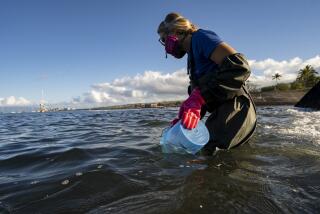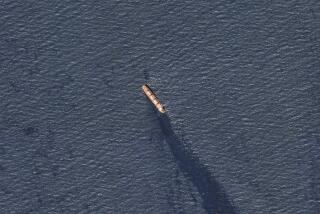Waterborne Debris Could Devastate Region’s Coral
- Share via
When giant tsunami waves smashed onto shores around the Indian Ocean on Sunday, they first killed tens of thousands of people. Then a massive backwash returned to sea carrying a deadly cargo that could destroy the region’s vital coral reefs.
“The water picks up sediment, trees, buildings, cars, and brings them back across,” said Clive Wilkinson, coordinator of the Global Coral Reef Monitoring Network in Australia. “It could pound the corals to sand.”
For now, officials and scientific experts in affected areas are focused primarily on aiding the survivors of the disaster.
“The first priority is obviously on helping the victims, the poorest of the poor.... They have lost everything,” said Marco Noordeloos, manager of a reef-preservation project for the WorldFish Center, a research agency based in Penang, Malaysia, that promotes sustainable coastal development.
But as they think about longer-term implications, many scientists are anticipating devastation of reefs, coastal wetlands and the fish populations they support.
The tsunami hit reefs left vulnerable by global warming, increased tourist activity, and such local practices as the illegal but widespread use of explosives to kill or stun fish, known as “blast fishing.”
“Coral reefs are already drastically affected by overfishing, pollution and disease, then a natural disaster is just another add-on to the litany of environmental insults,” said Jeremy Jackson, a professor at Scripps Institution of Oceanography in San Diego.
“In the past, a huge natural disturbance would be weathered in stride,” he said. “But in a time when people are the greatest force working against the ecosystem,” the giant tsunami could be a killer blow to some reefs.
Jamaica offers a case in point. Weakened by pollution, overfishing and tourism, the island’s reefs never fully recovered from Hurricane Allen in 1980.
“Those coral reefs were waiting to die, and we were just not smart enough to see it,” Jackson said. “Given what we’ve learned about the synergy between natural disturbance and human disturbance, the projection would have to be fairly grim.”
Damage to the reefs could cause many problems. Not only are they a major tourist attraction in several South Asian countries, they also provide a hatchery for fish, making them a key link in ocean ecology.
In some hard-hit areas, damage to reefs is already apparent. Thailand’s popular tourist area of Phuket beach was piled with dead marine animals, including staghorn corals, starfish and sea cucumbers, reported The Nation, a Bangkok newspaper.
The coral in nearby shallows was destroyed, crushed and shrouded in debris.
“It could take 20 years to rehabilitate the reefs back to the beautiful diving sites they were,” said Somchai Sakulthap, a professor of environmental sciences at a local university.
Some reefs could improve more rapidly if enough coral survived to regenerate adjacent areas. After tsunamis hit the Pacific side of Indonesia in 1992 and 1994, local reefs improved significantly in just a few years.
But those events were relatively localized. Scientists could cite no precedent for Sunday’s massive disaster, making prediction difficult.
“We just shrug our shoulders and say we don’t know. It’s such a rare event,” Wilkinson said.
A recent survey of 240 experts from 96 countries concluded that 20% of the world’s coral reefs were dying.
In Southeast Asia and the Indian Ocean, more than one-third of reefs were judged to be threatened.
In addition to the reef damage, the tsunami almost certainly will have a lingering effect on the livelihoods of fishermen and coastal farmers. Wetlands and rice paddies could take years to recover from inundation with salt water.
In the last decade, mangrove trees were removed from large coastal areas of Thailand, India and Sumatra to make room for prawn ponds and other commercial fisheries.
“The [tsunami] surge would have gone through and ripped them right out,” releasing pesticides, antibiotics and massive quantities of nutrients, Wilkinson said.
The effects of that pollution, added to raw sewage released by the disaster, could further harm coral habitats and threaten already depleted fish stocks.
Efforts to assess environmental consequences could be hampered by the tsunami’s massive damage to the National Aquatic Resources Research and Development Agency in Sri Lanka, one of South Asia’s most important reef research stations.






